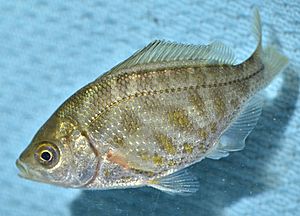Tule perch facts for kids
Quick facts for kids Tule perch |
|
|---|---|
 |
|
| Hysterocarpus traskii pomo | |
| Conservation status | |
| Scientific classification |
The tule perch (scientific name: Hysterocarpus traskii) is a special type of fish. It's a kind of surfperch, but unlike most surfperch, it lives only in fresh water. You can find these fish in the rivers and estuaries of central California, USA. It's the only fish in its group, or "genus," called Hysterocarpus.
Contents
What Does a Tule Perch Look Like?
Tule perch are small fish. They usually grow up to about 15 centimetres (5.9 in) (6 inches) long. They have a deep body shape. You might notice a small hump on their back, right behind their head.
Their colors can change a lot. Their back is usually dark, sometimes with a hint of blue or purple. Their belly is lighter, often white or yellowish. The sides of the fish can have stripes, either thin or wide. How often these stripes appear depends on the specific type of tule perch.
Fins and Scales
The fin on their back is called the dorsal fin. It has a line of scales along its bottom edge. This fin has 15 to 19 sharp spines. After the spines, there are 9 to 15 soft rays.
The fin on their underside, near the tail, is the anal fin. It has three spines. It also has 20 to 26 soft rays. The fins on their sides, called pectoral fins, have 17 to 19 rays.
Where Do Tule Perch Live?
Tule perch live in flat, low-lying areas. They prefer lakes, slow-moving streams, and rivers. You can often find them where there are lots of plants underwater. They also like areas where trees or bushes hang over the water.
These fish usually swim together in groups. Sometimes, there can be many of them in one spot!
What Do Tule Perch Eat?
Tule perch mostly eat small bugs and other tiny creatures. They suck them up from the bottom of the water. They might also pick them out of the water as they swim.
Types of Tule Perch
Scientists recognize two main types, or subspecies, of tule perch.
- Russian River tule perch (Hysterocarpus traskii traskii): This type was originally found in many places. These include Clear Lake, the Russian River, and the Sacramento River-San Joaquin River area. They also lived in estuaries around San Francisco Bay and the Pajaro River-Salinas River systems. Today, they are still common in the north, like the Pit River. However, they are mostly gone from the San Joaquin basin. About 43% of these fish do not have stripes on their sides.
- Central Valley tule perch (Hysterocarpus traskii pomo): This type is found in the Central Valley river systems.
How Tule Perch Were Discovered
The tule perch was first officially described by a person named W. P. Gibbons. He shared his findings at a meeting in California on May 15, 1854. What's interesting is that the description was then published in a newspaper! It appeared in "The Daily Placer Times and Transcript" on May 18, 1854. This was unusual because new species are usually announced in science books or journals, not newspapers.
Gibbons chose the name Hysterocarpus for the fish's group. This name means "womb-fruit." It refers to how all surfperch, including the tule perch, give birth to live young instead of laying eggs. The second part of the name, traskii, honors John B. Trask. He was a friend of Gibbons and a doctor who also studied rocks and the Earth. Trask was also one of the people who helped start the California Academy of Sciences.


